Ophthalmic eye drops. Antiseptic eye drops
Eye drops are used in ophthalmology for the treatment of diseases of the anterior segment of the eye. Here are listed the main drugs in the form of eye drops, used in modern Russian ophthalmology: indications, contraindications, route of administration and doses, side effects and storage conditions. If you have experience using the presented tools, you can write your own review, which other visitors of the site can read.
All drugs are divided into groups according to their action:
Eye drops for tired and dry eyes
This section presents the main preparations recommended for use in order to eliminate fatigue and dry eyes. They are used with a lack of tears (""), while working at a computer ("Computer Visual Syndrome"), as well as under the action of unfavorable non-infectious factors in the external environment (irritation of the eye mucosa after the pool). Eticaly for the eyes are sold without a prescription and can be used by the patient on their own.
Japanese eye drops
Katahrom;
Emoxipin and others.
Eye drops of this group are prescribed to slow the development of age-related changes and dystrophic processes in the tissues of the eye, as well as in the treatment of cataracts. Such drops contain active ingredients that help the eyes get oxygen and nutrients, help to improve microcirculation in tissues, restore the functions of the eye, slow down age changesdestroying the organ of vision.
Moisturizing eye drops:
Licontin;
Vidisik;
Hilo-dresser, etc.
Eye drops with a moisturizing effect are indispensable in the treatment of dry eye syndrome - a disease in which the outer shells of the eye, the cornea and conjunctiva, for one reason or another, dry out. Dryness, burning, pain, redness of the eyes - symptoms familiar to anyone who works at the computer or wears. These discomfort can be quickly and permanently removed with the help of moisturizing eye drops. Such drops have almost no contraindications and side effects and are most often sold without a prescription.
Antibacterial and antiviral eye drops:
Levomitsetin;
Cypromed;
Oftakviks;
Tobrex;
Ophthalmoferon, etc.
If eye disease is caused by bacteria or viruses, these eye drops are indispensable. Only the doctor prescribes drops of this group - each of the drugs has strict indications.
Vasoconstrictor drops:
Naphthyzinum;
Eye drops that have a vasoconstrictor effect are used for swelling and redness of the eye mucosa. Such symptoms may be due to an allergic reaction, inflammatory processes, irritation of the mucous membrane of the eyes. The result of applying these drops is usually noticeable fairly quickly - when the vessels narrow, the redness and swelling decrease in a few minutes. But y vasoconstrictor drops There is a particular application - they can be addictive, so they should be used only according to the indications and for a short time.
Anti-glaucoma eye drops:
The name speaks for itself - this group of eye drops is used strictly for the treatment of glaucoma, a disease in which intraocular pressure constantly or occasionally increases, as a result of which vision deteriorates, atrophic processes may develop. Eye drops for the treatment of glaucoma are designed to reduce intraocular pressure. They should be taken only on prescription.
What you need to know about the correct use of eye drops?
1. Eye drops should be prescribed by a doctor. At best, self-prescribed drops simply will not work, at worst, the condition may worsen markedly. The specialist selects the drug for the treatment of your disease and prescribes its dosage, which must be strictly followed.
2. In the event that several ophthalmic preparations are prescribed, do not forget to take breaks of 15-20 minutes (or as indicated by the doctor) between the instillation different types drops. If the doctor says that the drops should be applied in a certain order, do not neglect this recommendation.
3. The pharmacy was not prescribed by an ophthalmologist eye drops? It should not be alone or on the recommendation of a pharmacist to replace them with drops with a similar composition. Even if the same active ingredient is indicated on vials from different manufacturers, eye tissue may unpredictably respond to another drug. Only a specialist can select the appropriate analogue.
4. Strictly observe the storage mode of eye drops - if it is stated that they should be stored in the refrigerator, in a dark place, away from children, follow these recommendations.
5. Do not forget about the shelf life - on average, eye drops can be applied within a month from the moment of opening the bottle and only if the appearance, color and consistency of the solution have not changed. Even if the bottle was not opened, after the expiration date (on average, 2 years), drops cannot be used.
Wash your hands. When using drops, it is easy to put an infection in the eyes - just touch the tip of an open bottle to any surface, including the eyelid or hands, and then drop them. To reduce the risk of infection, before opening the drops, always wash your hands thoroughly and try not to touch anything with the tip of the bottle.
Heat the drops. Cold drops are absorbed poorly and can irritate the eyes. If you store eye drops in the refrigerator, they need to be slightly warmed before use. Do not do it in the microwave. Dip a closed vial into a cup of hot water, or place it under a stream of water by opening the tap.
Remove the lenses. If you wear contact lenses, remove the lenses from your eyes before applying the eye drops. You can wear lenses 15-20 minutes after using the ophthalmic preparation.
Do not use other people's drops. In order to avoid infection and inflammation of the eyes, do not give anyone your eye drops and do not use someone else's open bottle of the drug. Eye drops - like a toothbrush, are applied strictly individually.
They have the ability to stop the vital activity of pathogenic microorganisms and inhibit their development. These medicines are used in all areas of medicine, including ophthalmology. Antibacterial eye drops can cope with the inflammatory process of infectious etiology and relieve the symptoms of the disease. Apply them only for the purpose of the specialist. The doctor determines the treatment regimen and the optimal dosage.
Indications for appointment
In modern ophthalmology, eye drops with an antibiotic in the composition are prescribed if a patient is diagnosed inflammatory process, the development of which is provoked by a bacterial pathogen. A specialist may prescribe such drugs to a patient in the following cases:
- treatment or prevention of keratitis, blepharitis, conjunctivitis, purulent processes, meibomita;
- complex treatment of viral or adenovirus infection;
- prevention of inflammation after an eye injury;
- prevention of ophthalmologic pathologies after surgery.
Even the most innocent eye diseases can lead to a deterioration or loss of vision. Therefore, do not neglect the appointments of an ophthalmologist. Antibacterial eye drops effectively combat pathogens at the local level and help prevent the development of complications.
What antibiotics are used in ophthalmology?
Antibacterial drops contain components that can kill pathogenic microorganisms or prevent their growth and development. In the first case we are talking about bacteriostatic action, and in the second there is a bactericidal effect. These properties have various

In ophthalmic practice, almost all known types of antibacterial substances are used: fluoroquinols, tetracyclines, aminoglycosides, macrolides, chloramphenicols, and sulfonamides. Each group has a specific spectrum of action and contraindications. Therefore, only an ophthalmologist (optometrist) can select individually, taking into account the age of the patient, the presence in the history of allergic reactions, antibacterial eye drops.
List of popular antibacterial eye drops
Choosing eye drops with an antibiotic, it is necessary to pay attention to the composition. Some components may cause allergic reaction. You should also consider the sensitivity of pathogenic microorganisms to the active substance.
The following antibacterial eye drops are considered effective:
- Tobrex;
- "Levomitsetin";
- "Albucidus";
- "Normaks";
- Sulfacyl Sodium;
- "Cipromed";
- Floxal;
- Sofradex;
- "Vitabact";
- "Tobradex";
- Fuzzitalmik;
- "Oftadeks."
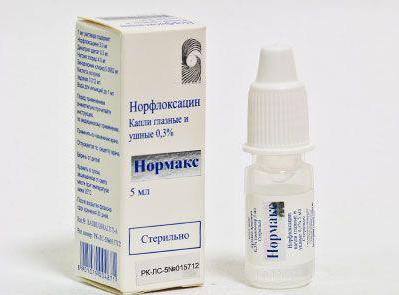
The duration of treatment with antibacterial eye drops will depend on the severity of the patient's condition. Positive dynamics is observed already on the 2-3rd day after the start of therapy. In the absence of improvement, the patient should consult an ophthalmologist.
Antibiotic eye drops for children
Inflammatory babies are more common than in adult patients. The causative agents of such pathologies are usually streptococci, staphylococcus and the most common pathology is conjunctivitis. The disease can have a bacterial, viral and allergic etiology. In the first case, doctors always prescribe antibacterial eye drops.
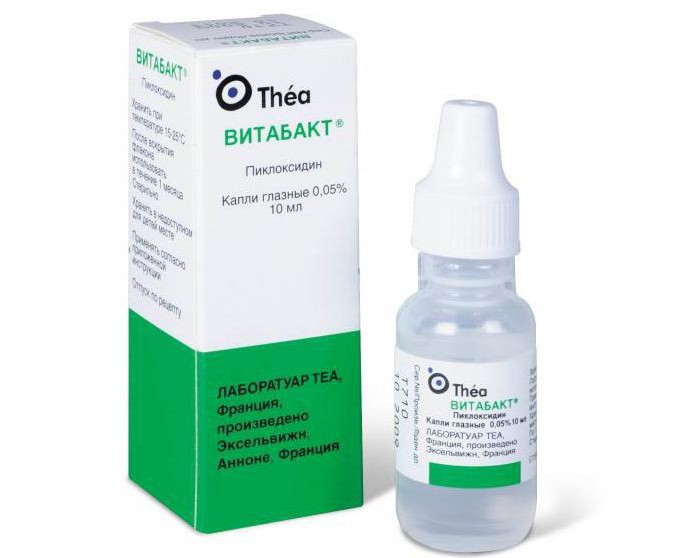
Selected with extreme caution. An antimicrobial agent can be prescribed only after determining the type of pathogen. In inflammatory infectious processes, babies are most often prescribed such drops as “Tobrex”, “Albucid”, “Ciprofloxacin”, and “Floxal”.
Antibacterial eye drops for newborns are buried immediately after birth. This practice allows you to prevent the development of infectious diseases caused by the passage through the birth canal.
Drops "Tobreks"
It is considered the means "Tobreks", the active ingredient of which is tobramycin from the group of aminoglycosides. The drug is highly effective, it is often prescribed for the treatment of various diseases in ophthalmology. A newborn (under the supervision of a physician) may also be discharged these antibacterial eye drops.
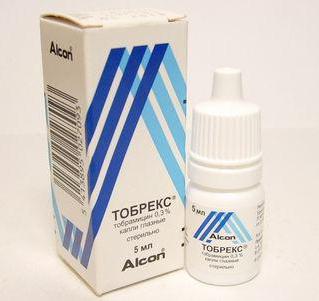
Children's drops "Tobreks" used in pediatric practice for the treatment of conjunctivitis, blepharitis, keratitis and other inflammatory processes. The tool effectively eliminates inflammation, relieves puffiness and fights pathogenic pathogens: staphylococcus, Klebsiella, streptococcus, diphtheria and E. coli.
The tool rarely causes side effects. Sometimes patients complain about the appearance of cramps in the eyes, redness and swelling of the eyelids.
Dosage
Adult patients, according to the instructions, means instilled 1-2 drops up to 6 times per day (every 4 hours). The duration of treatment is 7-10 days. Improvements are usually observed on day 2. The quantity decreases purulent dischargeredness and burning.
Children are allowed to dig in 1 drop of the drug up to 5 times per day. The exact dosage should be calculated by a pediatrician or an ophthalmologist, considering the age of the small patient. Apply drops "Tobreks" can be within 7 days.
“Sulfacyl sodium”: who is suitable for these eye drops
Able to cope with neonatal biliary disease, conjunctivitis, keratitis, purulent ulcers and other eye diseases. Drops have antiseptic, bactericidal and antibacterial action. They prevent the development of pathogenic bacteria (gram-negative and gram-positive).

1-2 drops of “Sulfacyl-sodium” are instilled in adult patients. The multiplicity of the use of funds - up to 5-6 times a day. The solution can be 10, 20 or 30%. In the period of gestation, these antibacterial eye drops can be given to a woman. For pregnant women, the remedy is absolutely safe. Also, drops are used if necessary treatment. infectious diseases eye during lactation.
Newborn babies are buried immediately after birth. Sulfacyl sodium effectively prevents the development of a bacterial infection. For treatment, apply 10 or 20% solution.
Futsitalmik tool
Antibacterial drops for eyes "Flucitalmic" have the form of a viscous suspension and are distributed in tubes of 5 g. Also, the tool is also available in liquid form. Antimicrobial action medication provides fusidic acid - a substance produced during the biosynthesis of the fungus Fusidium coccineum. The component is active in relation to staphylococcus, hemophilus bacillus and streptococcus.
The viscous consistency of the drug provides a longer therapeutic effect. The tool can be used to treat blepharitis, keratitis, conjunctivitis, dacryocystitis in adults and children. It is much easier for kids to drip a viscous suspension into their eyes than drops.

For the treatment of children and adult patients, it is necessary to apply the medication twice a day. The duration of therapy is 7 days.
The drug "Flucitalmik" rarely causes side effects. Contraindications to the appointment is only intolerance to the components in the composition of the tool. During pregnancy and lactation, antibacterial drops can only be prescribed by the attending physician if the expected benefit greatly exceeds the risk of side effects.
Antibacterial eye drops when wearing lenses
If the rules of wearing, storage and hygiene of the lenses are not followed, various inflammatory processes can develop: keratitis, corneal erosion, conjunctivitis. In the case of a bacterial infection, antibacterial eye drops will have to be used. At the time of treatment pathology should refuse to wear lenses. Antibacterial components in the composition of drugs can cause their turbidity.
Antiviral eye drops are prescribed for the treatment of viral eye lesions. When is it appropriate to use drugs of this group? What is the basis of their action? What antiviral drugs are most often prescribed by doctors? In which cases the use of drugs is contraindicated? Answers to the questions you will find in the article.
Antivirals are used in the treatment of inflammatory processes caused by viruses. This is viral:
- keratitis;
- keratoconjunctivitis;
- uveitis;
- optic neuritis.
The most common pathogens causing inflammation ophthalmic tissues are adenoviruses (provoke conjunctivitis) and herpes viruses (infect the cornea). More rarely, cytomegalovirus, picornavirus and enterovirus provoke the disease (they are the causative agents of hemorrhagic conjunctivitis, which is characterized by hemorrhage).
Contraindications
Use antiviral drops contraindicated in:
- hypersensitivity or intolerance to one of the components of the drug;
- low blood levels of leukocytes and platelets;
- diseases of the cardiovascular system, kidney, liver;
- disorders of the thyroid gland;
- mental disorders;
- epilepsy.
Depending on the type of specific antiviral agent, drops are either contraindicated during pregnancy, or their use is allowed, but with great care, only under the supervision of a doctor.
Side effects
Agents with antiviral action are highly effective. But in some cases, the use of drops causes quite serious adverse reactions. Most often, patients noted:
- increased drowsiness;
- anxiety, depressed mood, apathy;
- chills, fever;
- severe headaches;
- general weakness, decreased performance;
- increased sweating.
Kinds
Antiviral drops in the eyes according to the composition and mechanism of action are divided into 3 groups.
- Virucidal Purposefully destroy viruses that cause inflammation.
- Interferons. They contain a synthetic analogue of natural interferon, produced in the human body by cells of the immune system to fight infection.
- Immunomodulators. Stimulate the production of its own interferon, helping to fight infection and increasing local immunity.
Oftan Idu
The drug based on idoxuridine belongs to the group of virucidal agents. The main component of the drug changes the structure of the virus, which leads to its death.
The tool is used in the treatment of infectious eye lesions in children and adults, namely:
- keratitis and keratoconjunctivitis caused by the herpes virus;
- other viral lesions of the eye tissue;
- tree corneal ulcer.
Antiviral agent is contraindicated in case of allergy to components of the solution, deep keratitis and iritis. Also, the drug is not prescribed simultaneously with steroid anti-inflammatory eye drops and ointments.
The drug is quite toxic, often causes the development of local adverse reactions:
- burning and soreness in the eyes;
- lacrimation;
- photophobia
Disturbance of accommodation, development, clouding of the cornea epithelium and formation of scarring on the conjunctiva are among the more severe unpleasant consequences of drug treatment.
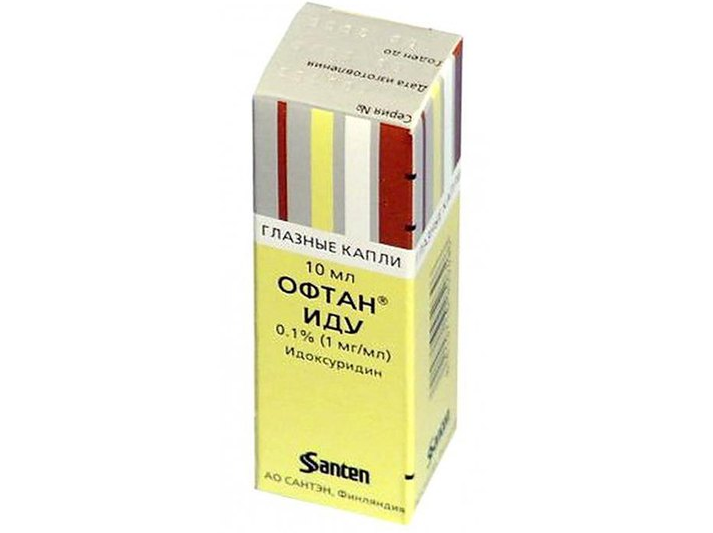 After applying Oftan Ida drops, severe headaches can occur.
After applying Oftan Ida drops, severe headaches can occur. The drug Oftan Idu, like other virucidal antiviral eye drops, inhibits metabolic processes, respectively, slows down the healing and repair of corneal tissue affected by the virus.
Mode of application: the first day - drop by drop every hour and night every 2 hours, after improvement of the condition - drop by drop every 2 hours during the day and every 4 hours at night, for 3-5 days.
Average cost: 300 rubles (10 ml bottle).
Ophthalmoferon
Antiviral agent of the interferon group is widely used in the treatment of infectious eye inflammation in children and adults. In addition to interferon, which has antiviral and immunostimulatory effects, the drops include:
- antiallergic component diphenhydramine (dimedrol);
- boric acid exhibiting antiseptic properties;
- a polymer that moisturizes the eye mucosa, eliminating dryness and irritation.
- antiviral;
- immunomodulatory;
- antiallergic (eliminates itching, swelling, redness);
- anesthetic;
- antiseptic;
- regenerating;
- moisturizing.
Antiviral eye drops are prescribed for conjunctivitis, keratitis, keratoconjunctivitis, and keratouveitis, the causative agents of which are adenoviruses, enteroviruses, simple or herpes zoster virus. Also, the drug is effective in dry eye syndrome, as a prophylactic after keratoplasty (prevents recurrence of herpetic keratitis).
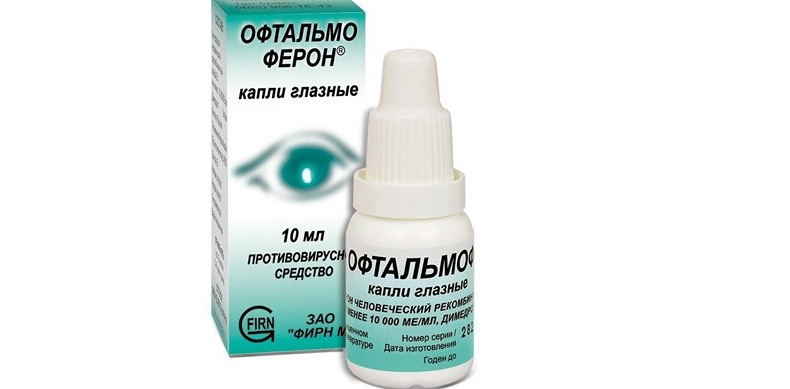 Ophthalmoferon can be used in combination with other eye drops - anti-inflammatory, antibacterial, moisturizing.
Ophthalmoferon can be used in combination with other eye drops - anti-inflammatory, antibacterial, moisturizing. Application Mode:
- viral infections - 1–2 drops up to 6–8 times a day - in case of acute inflammation, up to 3 times a day - as symptoms decrease during 7–10 days;
- with dry eye syndrome, 1–2 drops twice a day for a month;
- after keratoplasty to prevent recurrence of keratitis - 1-2 drops to the operated eye up to 4 times a day for two weeks.
Average cost: 400 rubles (10 ml bottle).
Okoferon
Another drug based on synthetic interferon. Available in the form of a lyophilized powder for the preparation of a solution to which the solvent (nipagin) is applied.
Antiviral eye drops are used in the treatment of keratoconjunctivitis, keratouveitis and other eye damage caused by viruses.
The drug is highly safe. The only contraindication to its use is individual intolerance to the components. Very rarely do they develop after instillation of a solution local reactions - burning sensation foreign body in the eye, blurred vision, allergy (redness and swelling of the eyes, a rash on the eyelids).
Mode of application: 2 drops every 2 hours, as the intensity of inflammation decreases, 2 drops every 4 hours, for 7–10 days.
Poludan
The drug based on polyadenylic and polyuridic acids belongs to the group of interferon inducers. It has a pronounced immunostimulating and antiviral effect. It is used in the treatment of eye lesions caused by herpes infection or adenovirus.
The drug, often used in adult therapy, is usually well tolerated. However, the likelihood of local adverse reactions cannot be completely excluded. To possible side effects Medicines include:
- eye redness;
- itching, burning sensation;
- increased intraocular pressure.
If these symptoms appear, the drops should be stopped. Unpleasant sensations pass independently after drug withdrawal; they do not require additional treatment.
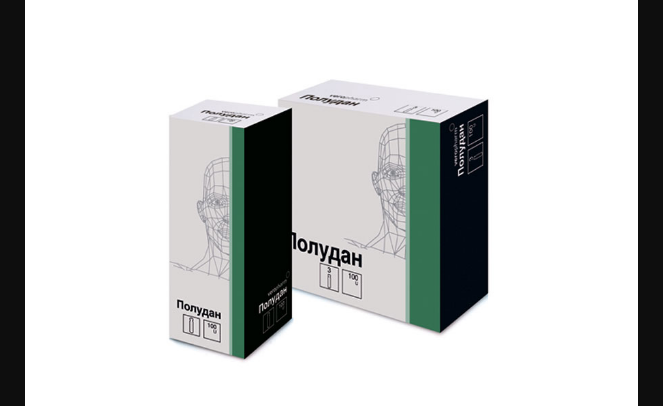 With the simultaneous use of Poludan with enzyme preparations, its effectiveness decreases as the enzymes destroy interferon.
With the simultaneous use of Poludan with enzyme preparations, its effectiveness decreases as the enzymes destroy interferon. Mode of application: 1-2 drops up to 8 times a day for acute inflammation, then three times a day. The duration of therapy is 7-10 days.
Average cost: 450 rubles (5 ml bottle).
Aktipol
Like Poludan, Aktipol is an interferon inducer. However, the main active ingredient of the drug is para-aminobenzoic acid. Actipol has a complex effect on eye tissue, namely:
- increases local immunity;
- eliminates inflammation caused by adenoviruses and herpes virus;
- helps to restore corneal tissue after injuries and burns;
- restores tissue in degenerative diseases of the cornea and retina;
- eliminates the symptoms of chronic eye fatigue;
- normalizes water and electrolyte balance, reduces tissue swelling;
- exhibits antioxidant properties.
In case of individual intolerance of the components included in the composition of the drug, it may cause reddening of the eyes, an allergic reaction.
Mode of application: 1-2 drops from 3 to 8 times a day for 7-10 days.
Average cost: 250 rubles (5 ml bottle).
Conclusion
Antiviral eye drops - an effective tool to help get rid of infectious eye inflammation. However, they should be used as directed by the physician, since only a specialist can determine the exact appearance of the pathogen based on the results of relevant tests and diagnostic studies. In the case of a bacterial or fungal infection, antiviral drops will not only not help, but will also aggravate inflammation.
In the case when the eye disease is different infectious, viral or fungal nature, it is impossible to cure it without the use of antibiotic therapy aimed at getting rid of all pathogenic microorganisms. If you do not take antibiotics, you can not fully recover, and the clinical picture can only progress. Antibacterial drops for the eyes - which are most in demand in modern ophthalmology, they gently and purposefully act precisely on the hour of the disease.
We will talk about the types, methods of treatment and use of these drugs for the eyes in the article.
What are antibacterial eye drops?
In most cases, bacteria cause the development of eye diseases such as:
inflammation in the lacrimal sac (dacryocystitis);
barley;
a lesion of the (ulcerative) membrane that covers the pupil and iris;
inflammation of the eyelids (blepharitis), cornea (keratitis), eye mucosa (conjunctivitis);
chronic infections.
Also, bacteria contribute to the formation of purulent inflammationsas post-traumatic and postoperative nature. Exactly medications intended for the treatment of bacterial infections of the eyes and their appendages.
Antibacterial eye drops are the most numerous subgroup of antimicrobials that may contain antibiotics or sulfa drugs.
In the photo: antibacterial eye drops
Drops for the eyes, which include antibiotics - drugs, the active ingredient of which are semi-synthetic or natural compounds that can kill pathogenic microorganisms.
In medicine, an antibiotic for the eyes uses the ability of some organisms to secrete substances that inhibit microbial microflora.
Eye drops with an antibiotic are divided into groups:
aminoglycosides: drops Tobramycin (Tobreks, Dilaterol), Gentimitsin;
chloramphenicol: Levomycetin;
fluoroquinolones ( Tsipromed, Tsiloxan, Tsiprolet); Ofloxacin, Levofloxacin.
Types of antiseptic eye drops

If an eye infection occurs, the patient must pass a spectral analysis to determine his sensitivity to antibiotics. wide spectrum action for the eyes and detect the causative agent of the disease.
Antibiotics that are used to treat the eyes, depending on the action on the bacteria are:
1. Violating the structure of the bacterial cell wall ( Tsipromed, Tsiprolet).
2. Able to disrupt the structure of the membranes of (cellular) pathogens ( Polymyxin).
3. Preventing the process of synthesis (association) of nucleic acids ( tetracycline ointment, Tobramycin).
Consider the most popular eye drops of this subgroup.
Albucid

It is considered an antimicrobial and antibacterial drug, the group is sulfonamides. Antibiotic eye drops do not allow microorganisms to multiply.
It is prescribed for various inflammatory or infectious eye diseases (front part of the eye):
blepharitis;
gonorrheal eye diseases;
conjunctivitis.
Before you use antibiotic drops in your eyes, contact lenses must be removed so as not to damage their transparency. Albuzid solution 30% is assigned to adults, 20% children. Acute inflammation It is treated by instilling 2-3 drops 5-6 times a day, when the patient's condition improves, the amount of the drug decreases.
The drug is used to prevent inflammation with purulent contents in newborns, most often appointed immediately after birth 2 drops of the solution and the same after 2 hours.
Antiseptic eye drops Levomycetin
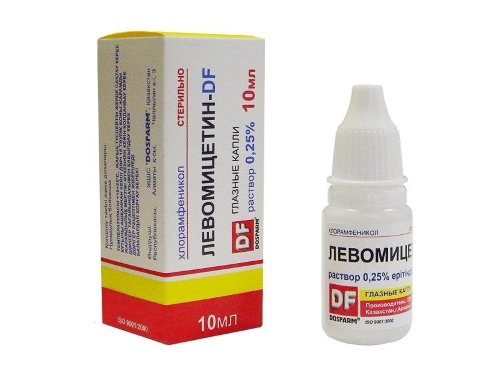
This drug is an antibiotic widely used in ophthalmology, which has a wide spectrum of action, has a good bacteriostatic effect, and is able to stop protein synthesis in microorganisms.
Levomycetin is prescribed for:
conjunctivitis and keratoconjunctivitis;
keratitis;
blepharitis and blepharoconjunctivitis.
The duration of treatment is 2 weeks, the drug should be instilled 3 times a day, 1 drop in each eye.
Sodium sulfacyl
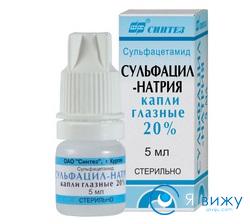
Photo: Sodium sulfacyl eye drops.
These antibacterial drops in the eyes have a bacteriostatic and antiseptic effect, they kill pathogens and prevent them from reproducing.
The drug is indicated for use in:
blephritis;
conjunctivitis;
eye diseases of gonorrhea and chlamydia;
corneal ulcers (purulent);
removal of inflammatory processes in contact with the eyes of a foreign body;
eye wounds (infected);
prevention of the development of purulent inflammation in newborns.
The dose is prescribed by the ophthalmologist after diagnosis and visual inspection. Most often, the dosage is as follows: 1-2 drops of the drug 3-5 times a day.
Eye drops from Tobrex infection

The drug is a broad-spectrum antibiotic that belongs to aminoglycosides.
Assigned to:
blepharitis;
dacryocystitis;
iridocyte;
Meibomte;
kerato and blepharoconjunctivitis;
prevention of infections after surgery and injuries in the eye area.
Depending on the degree of development of the disease, Tobrex is used in 1-2 drops with an interval from 40 minutes to 4 hours. Do not use the drug when breastfeeding.
Floksal
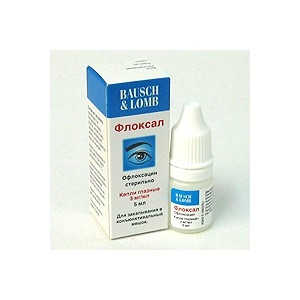
These antibiotics for the eyes in drops belong to the group of fluoroquinolones, have bactericidal properties, are effective in the treatment of gram-negative and gram-positive bacteria.
Ophthalmologists prescribe Floksal for:
treatment of inflammatory and infectious eye diseases (keratitis, barley, corneal ulcer, conjunctivitis);
preventing the formation of infection or inflammation after injury or surgery;
cure of an infection that appeared after surgery (surgical) on the eye or after injury to the eyeball.
Drops in the eyes, the antibiotic Floksal needs to be instilled 2-4 times a day, 1-2 drops in a sore eye, the duration is 10-14 days. In more complex cases, the simultaneous use of drops and ointment Floksal is recommended. During treatment, it is not recommended to wear contact lenses, and eyes should be protected from the sun glasses.
Normaks
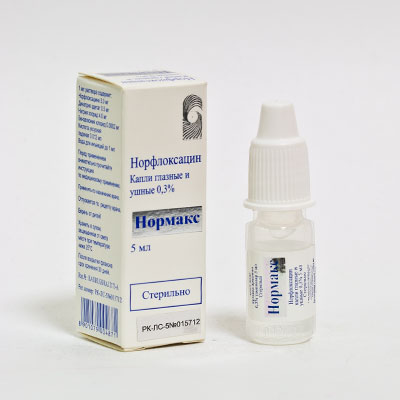
This drug is used in ENT practice or as eye drops. The antibiotic included in their composition belongs to the group of fluoroquinolones and has antibacterial properties.
Ophthalmologists recommend antiseptic eye drops - Normaks for conjunctivitis, bleferitis, corneal ulcers, as well as in the presence of chlamydial eye lesions. Treatment is carried out by instillation of the drug in 1-2 drops for an hour, 2-4 times, with the improvement of the patient's condition, the dosage is reduced and the eye drip should be 3-5 times a day.
Tobradex
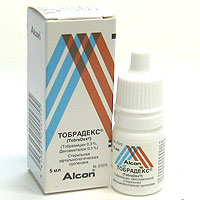
Eye drops with dexamethasone and antibiotic (tobramycin) - a combined drug, contains corticosteroid and antimicrobial components, has a bactericidal and anti-inflammatory effect.
Thoradex is prescribed to patients suffering from eye diseases accompanied by a bacterial infection (blepharitis, conjunctivitis, keratitis).
Cypromed
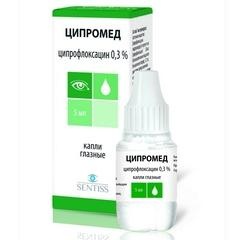
These eye drops with a broad-spectrum antibiotic belong to the fluoroquinolones and begin their bactericidal action within 15 minutes after instillation, the duration of the effect is 5-6 hours.
Tsipromed appointed:
as a prophylactic after surgery or eye injuries;
with conjunctivitis; iridocyclitis; uveitis, meibomites.
These eye drops from an eye infection are used 5-8 times a day, a few drops in the affected eye, this frequency is prescribed in the presence of a chronic inflammatory process in the eye, in the acute stage of the disease - 9-12 times a day.
Oftakviks
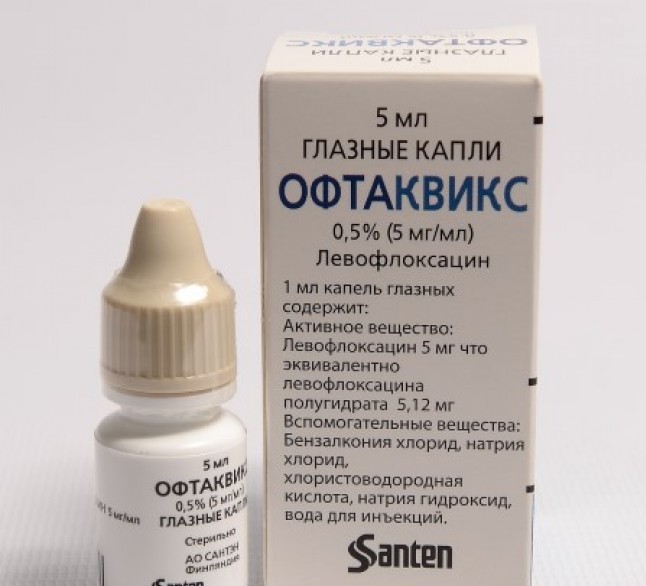
These antimicrobial eye drops are fluoroquinolones are prescribed for adults and children (older than one year). The drug is recommended for use in various infections of the eyes: keratoconjunctivitis, keratitis, corneal ulcer (bacterial).
It is necessary to use Oftakviks no more than 8 times a day (in the first days of treatment), after a few days the number of instillations is reduced to 4 times a day.
Eye drops, antibiotics, the list is not complete, we have described the most effective and popular drugs.
Is antibacterial eye treatment effective?

In the photo: eyes affected by a bacterial infection
When prescribing a doctor drops for eyes with antibacterial effect, both for children and adults, provides a lasting therapeutic effect.
Drops in the eyes of infection act on the focus of the development of pathology as follows:
treat and act as a prophylactic agent for eye diseases: fungal, infectious, inflammatory;
treatment in the complex of the eye disease;
prevention of the development of inflammation after surgery on the eye area.
When are antimicrobial eye drops prescribed?
These medicines have several main uses:
1. Prevention and treatment of eye diseases, both infectious and inflammatory, which are caused different species bacteria. These diseases include: purulent ulcer, blepharitis, conjunctivitis (for example), keratitis.
2. Prevention of infection and inflammation after various operations that are performed on the eyes. Such anti-inflammatory eye drops with an antibiotic are also prescribed before surgery.
3. Therapy (in combination), having a viral character, for the treatment and prevention of re-development bacterial infections. These eye diseases include: herpetic keratitis,.
4. Prevention of infection after injury to the eye.
Eye drops with a broad-spectrum antibiotic should be used after consulting with an ophthalmologist, who will accurately determine the dosage of the drug and the duration of treatment, depending on the individual case of the disease.
Antibacterial drops for children

Eye drops with an antibiotic for children are prescribed for bacterial conjunctivitis, inflammation of the eyelids or eye bag, to prevent purulent conjunctivitis in newborns.
Eye drops provide a good efficacy against Gram-positive microorganisms (Streptococcus and Staphylococcus). Fucitalmic, Tobreks.
Also used for the treatment of combined drugs, which include in its composition: antibacterial eye drops for children and corticosteroids and are used after surgery on the eyes ( Tobradex, Maksitrol).
You can also select the following drugs:
Tobramycin, Tobradex, Floksal - eye drops broad-spectrum antibiotics, which are allowed for use for newborns. This drug is resistant to penicillin, is able to quickly defeat staphylococcus. When applied topically, there is minimal risk for the child.
Ofloxacin, Uniflox - able to eliminate inflammatory and infectious processes in the anterior sections of the eye, which are caused by pathogenic microorganisms.
Antibacterial eye drops for children may have different active ingredients and the composition, their name may also differ, it all depends on the manufacturer. Analogs of medical preparations for the treatment of eye diseases should be selected only by a doctor, since Not all of them are suitable for children.
The most important condition when applied eye antibiotics: correctly selected drug and method of treatment. You should also observe the dosage and take into account possible side effects from taking the drugs.
Side effects of taking antibacterial drops can have various manifestations:
;
burning sensation after instillation;
slight tingling in the eyes.
In no case do not self-medicate, because this can lead to serious complications, fully follow all the prescriptions and advice of your ophthalmologist.
Antibacterial eye drops are prescribed for the detection of acute conjunctivitis, abscess, blepharitis, barley, furunculosis (with localization on the eyelids), meibomiitis and phlegmon.
When bacteria and protozoa infect the organs of vision.
Antibiotics in the composition of the eye drops are the main active substance, their influence inhibits the development of infection.
List of popular antibacterial drugs for eyes for adults
The list of popular antibacterial drops for adults:
- Penicillin in the form of a powder, diluted with boiled water, this patient’s eyes are washed several times a day.
- Sulfacyl sodium is another name for its albumin. The most popular drug for the treatment of purulent corneal ulcers, blepharitis and conjunctivitis.
- Chloramphenicol, known as chloramphenicol, is effective in treating infections in the organs of vision.
- Ciprofloxacin is used to treat inflammatory diseases organs of vision.
- Tobramycin - its active substance is dilaterol, which has a bactericidal property that quickly kills pathogenic cells.
- Tsipromed - drops for the treatment of inflammation of the eyelids of infectious origin, postoperative complications.
- Tobrex - drug local applicationwith a wide range of therapeutic action.
- Normaks effective for the treatment of infections derived from the introduction of staphylococci, streptococci.
These drugs are popular among patients, as their effectiveness has been tested in practice.
Dosage for children
Like adults, children are also very often exposed to microbes. Their fragile body requires careful selection of therapeutic agents for the treatment of organs of vision. Usually, children can suffer from meyobitis and conjunctivitis, keratitis and blepharitis, as well as uveitis.
Children are assigned the same therapeutic antibacterial drugs, as well as adult patients, only the dosage is prescribed another. To avoid allergies and other adverse events, only an oculist should prescribe eye drops.
Before this, the child must undergo a medical examination with specialists in order to present a complete picture of the pathology, to learn about the features of his body, susceptibility to drugs.
It is necessary to select such a therapeutic drug so that it is effective, does not cause adverse reactions. In any case, the choice of eye drops for children should be approached with caution.
The list of bacterial agents contains such eye drops:
To combat conjunctivitis use drugs: Dex-gentamicin, Trimethoprim and sodium Sulfacetamide, which have not observed the presence of side effects, they also differ in relative availability.
In the treatment of children's eye diseases, aminoglycosides cannot be used for a long time, since their prolonged use can lead to damage to the corneal epithelium.
Neomycin should be used with caution, it sometimes causes an allergic reaction in children. The drug Amikacin appeared in ophthalmology recently, has low toxicity, effectively treats children's diseases that are not amenable to treatment with Tobramycin and Gentamicin.
For the treatment of infectious conjunctivitis in children, the use of Erythromycin 0.5%, Povidone 2.5% and Normax gives a good result.
After one year of life, children can treat Moxifloxacin 0.5% for the treatment of Haemophilus and Chlamydia infections, providing satisfactory therapeutic effectBury it 3 times a day. 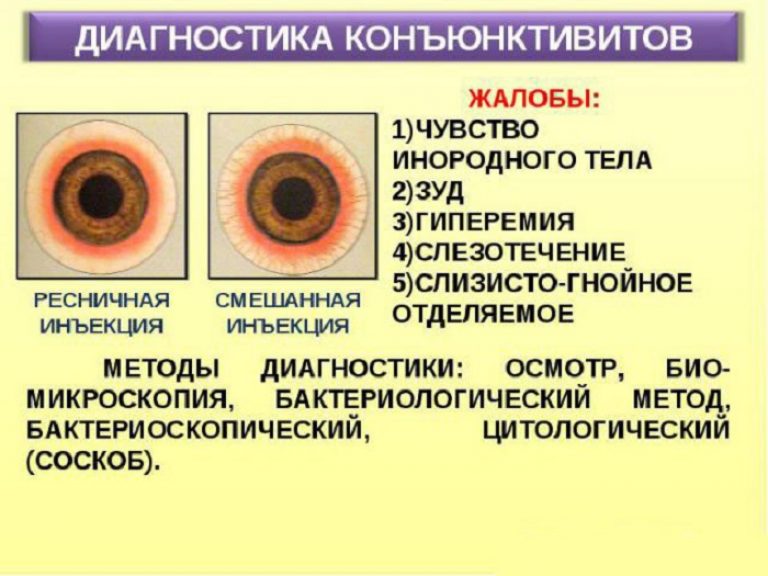
Use for the treatment of blepharitis with severe pathology, conjunctivitis and keratitis, as well as other infectious diseases of children's drops “Tobreks” kills pathogenic pathogens of eye diseases: staphylococci, Klebsiella, streptococci, eliminates puffiness, relieves inflammation.
Levomitsetin eye drops are prescribed for children with keratitis, conjunctivitis and blepharitis, starting from 4 months to 2 years very carefully, only in cases where there is no substitute for another means. Children bury it 5 times a day for 2 drops, after the onset of improvement, reduce to 3 times a day.
Antibiotic eye drops are drugs such as Tobradex and Tobramycin, which are also approved for use in newborns.
Floksal and Tsipromed are effective in combating keratitis, conjunctivitis, and can be used for prophylaxis before and after operations of the visual organ. The course of treatment is about two weeks.
The dose of reception is determined only by the ophthalmologist, taking into account the age of the child, the general state of health.
In which cases antibacterial drops are prescribed.
Healing eye drops with antibiotics are used to detect infections that cause inflammation.
Staphylococcus and enterobacteria are identified in the list of bacteria that cause diseases of the organs of vision.
They provoke the appearance of such diseases of the organs of vision:
- blepharitis - infectious inflammation on the edges of the eyelashes;
- conjunctivitis - inflammation of the mucous membrane of the eye;
- keratit and chalazion;
- gordelium (barley);
- meybonite.
Eye drops against bacteria are prescribed for the treatment or prophylaxis of infectious diseases of the organs of vision. Infections begin to develop when the mucous membrane with the cornea is affected by the action of pathogenic bacteria.
Aminoglycosides violate protein synthesis, these include the first-generation drugs such as neomycin and streptomycin, kanamycin with monomitsin.
The drug of the second generation - gentamicin. Preparations of the 3rd generation are considered the most effective, such as sizomycin and tobramycin, netilmicin and amikacin.
Fluoroquinolones are potent drugs, their effect is manifested within a few minutes after instillation. The first generation contains oxolinic, pipidemic and nalidix acids.
The 2nd generation drugs include lomefloxocin and ciprofloxocin, ofloxocin with pefloxocin. Levofloxacin with sparfloxacin are 3rd generation drugs.
The most potent drugs are mokifloxacin with oftaquix. The third group is chloramphenicol.
Levomitsetin - a drug related to antibiotics, but is applicable in complex therapy against viral infections.
Possible adverse reactions
Drugs other than benefits can be harmful to health. Among the most common adverse reactions can be noted drowsiness and apathy, headaches, fever with increased sweating, anxiety with hallucinations, as well as chills and decreased performance.
The popular drug levomycetin has by-effect, it causes: disruption in work nervous system, optic neuritis, as well as disturbances in blood formation in the form of a decrease in hemoglobin and changes in white blood cells, red blood cells, problems in the gastrointestinal tract.
Such side effects from Tobrex and Albucid eye drops are possible:
- changing the formula of blood;
- dizziness with hearing loss, loss of coordination of movement;
- nausea with vomiting;
- eyelid edema, burning and itching, watery eyes with redness of the conjunctiva;
- photophobia.
Dexamethasone eye drops cause burning after instillation. The consequence of long-term use is a decrease in visual acuity, thinning of the cornea.
Useful video on the topic
Contraindications to the use of funds
Any medicine has contraindications for use. Before using eye drops, it is recommended to examine the available contraindications on the liner to the drug.
Antibacterial drops can not be prescribed to patients:
- with individual intolerance to the drug;
- with heart, kidney, liver diseases;
- mental disorders;
- epilepsy.
The drug Dexamethasone can not be used for inflammation of the eyes:
- viral and fungal infections;
- mycobacterial infections (tuberculosis);
- acute bacterial infections.
In addition to these infections, dexamethasone should not be used in patients with elevated intraocular pressure (glaucoma), corneal defects, as well as those with increased sensitivity to the components of the remedy. 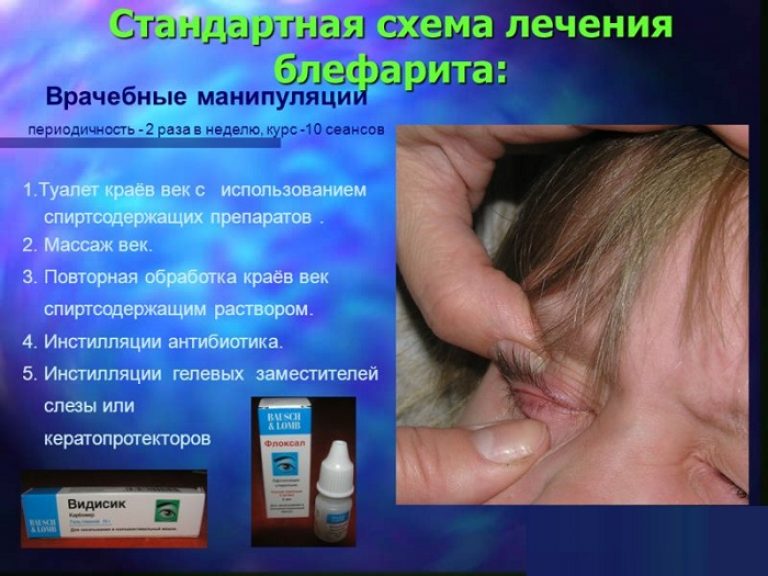
Cypromed eye drops are not suitable for treatment in the following conditions:
- if there is intolerance to the components of the drug;
- with keratitis viral type;
- children up to one year old;
- women when carrying a child and lactation.
Tobrex also has contraindications; he is not prescribed to such patients: with inflammation of the auditory nerve, kidney diseases.
Diclofenac eye drops with Indocollyr are not suitable for asthmatics, for violations of the blood formation and pathology in a patient gastrointestinal tract in the acute stage, as well as those who can not tolerate aspirin.
All antibacterial drops in the treatment of the organs of vision for pregnant and lactating women should be prescribed with great care, as they can harm the fetus and baby.
Differences of antiviral drugs from antibacterial
Synthetic-made preparations are used to fight bacteria. All types of antibiotics do not affect viruses. Viruses are fought with antiviral drugs.
Viruses are made up of a small chain of DNA or RNA; they are not susceptible to antibiotics. Bacteria have a cellular structure. Therefore, to treat viral diseases Eye antibacterial agents are not suitable.
When the pathologies of the organs of vision of a viral nature, antiviral agents give a good result. Viral infection, for example, herpes virus, enterovirus leads to inflammation of the tissues of the organs of vision.
One of these diseases is viral conjunctivitis, in which an interferon eye antiviral agent is prescribed. It is in powder form and in ampoules. Before use, the powder must be diluted with water, the instructions indicate the ratio of water and powder.
Tebrofen, 0.1% - instilled it against conjunctivitis caused by the herpes virus, causes a burning sensation.
Florenal - a drug used against viruses, can cause an allergic reaction in children.
As part of the means to combat viral infection there are interferons - substances with high activity against viruses.
Among antiviral drugs for the eyes, patients note efficacy from Ophthalmoferon, Poludan and Actipol.
Poludan stimulates the human immune system and helps to get rid of keratitis, uevita, treats neuritis of the optic nerve. The drug quickly penetrates the tissue and is eliminated from the body quickly.
Aktipol is an antiviral drug, widely used in various viral pathologies: herpes and adenovirus. It relieves eye fatigue, eliminates infectious, postoperative and posttraumatic keropathy.
Drops for treatment are strong meanstherefore, it can be used only after the appointment of an oculist.
Features of use at barley
Barley is an inflammation of the sebaceous gland with the introduction of Staphylococcus aureus into the external or internal surface of the eye eyelid. It appears in the form of a pustule, causing redness with swelling, burning in the eyelid area, which cause discomfort and tearing.
In order to get rid of these symptoms, you can buy in the pharmacy without a prescription drops "Albucid". This drug is the most accessible and popular, and most importantly, fast-acting remedy for barley.
"Levomitsetin" is also one of the proven and effective means against barley, which after the application facilitates the patient's condition.
In some cases, against barley, doctors prescribe a 1% penicillin solution, which is effective antibiotic purposeful action. It shortens the duration of the disease, accelerating the maturation of the abscess.
At application it is necessary to be careful as it has contraindications. It can not be used for asthmatics, allergies, those who are intolerant to penicillin.
Gentamicin - a strong antibiotic, gives a good result in the treatment of barley. It can not be used for herpetic keratitis and eye tuberculosis, chickenpox and fungal infections, glaucoma and sensitivity to the components of the drug.
The composition of "Tobreks" used in the treatment of barley, is characterized by the presence of a broad-spectrum antibiotic. This remedy has no contraindications for pregnant women and children.
It is distinguished by its delicacy; when Tobrex is used, irritation of the mucous membrane of the organs of vision is not observed.
When using any means you need to remember that without a doctor's prescription you can not use eye drops.
Anti-inflammatory eye drops with antibiotic
Infections of a bacterial nature cause inflammation in the organs of vision. To relieve inflammation prescribed Albucidum in the treatment of conjunctivitis and fungal diseases. 
L - Optician and Vitobact are antimicrobial dropsthat block the action of pathogenic microbes in conjunctivitis, keratitis and trachoma. Relieve inflammation.
The anti-inflammatory eye drops Tobradex have an anti-inflammatory effect, due to the antibiotic in the composition, therefore they are used for infectious inflammations.
Diclo-F refers to the anti-inflammatory drug, pain relief. Significantly lowers body temperature.
Dexamethasone is a synthetic drug that has an effect against inflammation of the organs of vision.
It is used to combat conjunctivitis, blepharitis, and is notable for efficacy in inflammation of the ocular membranes.
Hormonal eye drops are characterized by particularly strong anti-inflammatory properties, as they suppress inflammation at the cellular level. When instilled, they penetrate all tissues of the eye.
The popularity of such drugs spread eye drops Sofradex. The composition of this drug combines two antibiotics - Neomycin with Gramidycin C and anti-inflammatory agent Dexamethasone, which enhance the therapeutic effect of each other.
Effective and cheap options
The cheapest means:
- Tsipromed. The therapeutic substance of the drug is ciprofloxacin. It is used to combat inflammation of the eyes, as well as for preventive purposes in the period before and after surgery. For prophylaxis take medicine 1-2 drops every 4 hours. Do not assign to children under 1 year. The cost of Tsipromed is approximately 120-170 rubles.
- Albucid. Effective and cheap antibacterial drug for eyes on the basis of sulphatometida, produced in the form of a 20 and 30% solution. Use it to fight against infectious diseases of the organs of vision. Dosage depends on the severity of the disease. Pharmacy price Albutsida about 70 rubles.
- Floksal. Analogues of the drug are Dancil and Uniflox. Eye drops for the treatment of infectious and inflammatory diseases of the eye. The basis of the drug is the substance ofloxacin. The cost of Phloxal drops is approximately 180 rubles.
- Dilaterol. Analogs are Tobrott and Torbeks. Broad-spectrum antibiotic. Tobramycin - the main substance of the drug. Patients note its effectiveness in the treatment of infectious and inflammatory diseases of the organs of vision. Instill the drug in 1-2 drops every 4 hours, 7-14 days. The price varies from 120-140 rubles.
- Levomitsetin. It is characterized by antibacterial effects, effectively fights against infectious and inflammatory eye diseases. Use drops 3 times a day, 1 drop for 15 days. Price Levomitsetina in pharmacies about 30 rubles.
Popular
- Breast cancer is curable at any stage.
- The remedy for the cold Sinupret
- Azitrox - official instructions for use
- Chicken-bjaka: allowed antibiotics were found in Russian chicken
- Oral Cancer: Symptoms and Treatment
- Dark and thick blood during menstruation.
- Modern analogues of doxycycline tablets
- Is it possible to die from pneumonia
- What earwax will tell all about your health
- Tussin: instructions for use



